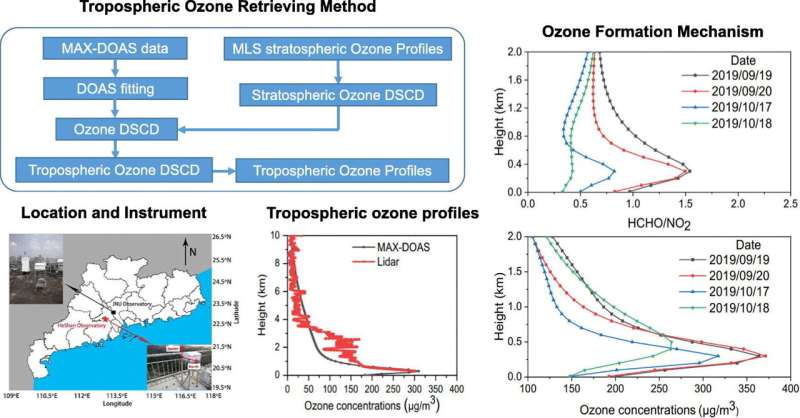Using a passive optical monitoring technique to retrieve tropospheric ozone profiles

A research team led by Prof. Si Fuqi from the Hefei Institutes of physical Science (HFIPS) of the Chinese Academy of Sciences (CAS) developed a new method to retrieve tropospheric ozone profiles. The corresponding results were published in Science of the Total Environment.
Ozone is involved in various chemical conversion processes of atmospheric pollution and is a typical secondary pollutant, especially in urban areas. Accurate monitoring of surface ozone concentration and vertical distribution is important to enhance the prevention and control of ozone pollution.
Multi-axis differential optical absorption spectroscopy (MAX-DOAS) is a passive optical monitoring technique that enables the retrieval of multi-component trace gases. However, the strong absorption of stratospheric ozone makes the retrieval of tropospheric ozone profiles with the MAX-DOAS technique a very challenging task.
In this study, Associate Prof. Luo Yuhan and Dr. Qian Yuanyuan at HFIPS innovatively employed MAX-DOAS measurements to retrieve tropospheric ozone profiles. They applied the methods in a SCIATRAN radiative transfer model to determine the influence of stratospheric absorption on the retrieval of these profiles.
Thanks to the optimal estimation algorithm, the researchers accurately obtained the absorption of troposphere ozone and reliable troposphere ozone profiles.
The inversion method was accurate, according to the team. They obtained tropospheric ozone concentrations during the PRIDE-GBA Campaign with it.
They retrieved ozone differential slant column densities using the "time-interpolated zenith spectrum" as the reference spectrum. By subtracting the simulated stratospheric ozone differential slant column densities, they calculated the precise tropospheric ozone differential slant column densities, which was simulated from the SCIATRAN model.
"We compared the observed ozone profile and surface ozone concentrations with Lidar and in-situ measurements," said Luo, "the results were highly correlated."
This study expands the application scenarios of the MAX-DOAS instrument and provides a new solution for studying the mechanism of tropospheric ozone formation.
Combined with the retrieved NO2 and HCHO profiles using the MAX-DOAS measurements, the mechanisms of regional tropospheric ozone pollution can be analyzed more accurately. Meanwhile, the cost of observation and instrument maintenance will be greatly reduced.
More information: Yuanyuan Qian et al, Retrieval of tropospheric ozone profiles using ground-based MAX-DOAS, Science of The Total Environment (2022). DOI: 10.1016/j.scitotenv.2022.159341
Journal information: Science of the Total Environment
Provided by Chinese Academy of Sciences





















